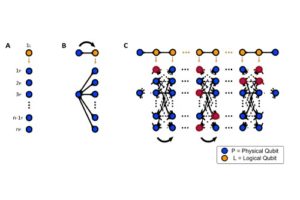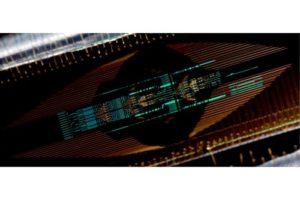
Physical qubits like photons, can be entangled to contain and protect logical qubits of information from environmental errors (red swirls).
A team of researchers from Bristol’s Quantum Engineering and Technology Labs (QETLabs) has shown how to protect qubits from errors using photons in a silicon chip.
Quantum computers are gaining pace. They promise to provide exponentially more computing power for certain very tricky problems. They do this by exploiting the peculiar behavior of quantum particles, such as photons of light.
However, quantum states of particles are very fragile. The quantum bits, or qubits, that underpin quantum computing pick up errors very easily and are damaged by the environment of the everyday world. Fortunately, we know in principle how to correct for these errors.
Quantum error-correcting codes are a method to protect, or to nurture, qubits by embedding them in a more robust entangled state of many particles. Now a team led by researchers at Bristol’s Quantum Engineering and Technology Laboratories (QETLabs) has demonstrated this using a quantum photonic chip.

The photonic chip generates and entangles ensembles of photons. It can implement a range of quantum error correcting codes.
The team showed how large states of entangled photons can contain individual logical qubits and protect them from the harmful effects of the classical world. The Bristol-led team included researchers from DTU in Copenhagen who fabricated the chip.
“The chip is really versatile. It can be programmed to deliver different kinds of entangled states called graphs. Each graph protects logical quantum bits of information from different environmental effects,” said Dr Caterina Vigliar, first author on the work.
“Finding ways to efficiently deliver large numbers of error protected qubits is key to one day delivering quantum computers,” said Anthony Laing, co-Director of QETLabs, and an author on the work.
The work is published in Nature Physics.




Tell Us What You Think!